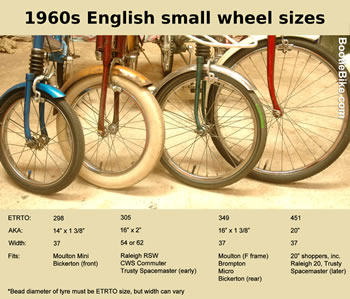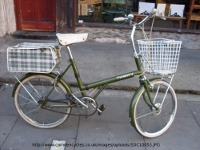About small wheelers
One of the common themes of this site is the influence of the Moulton, the 60s bike with the tiny wheels, suspension at each end and a look that hasn't aged in 50 years. The Moulton forever broke the mould of bicycle design and, for a while at least, resuscitated the moribund British cycle industry. The original Moulton, the 'F frame', is of course long gone, but its influence lives on, not only in small wheelers, but in just about every bike that doesn't have a traditional diamond or step-through frame.
but its influence lives on, not only in small wheelers, but in just about every bike that doesn't have a traditional diamond or step-through frame.
The story began in the late 1950s, when Alex Moulton, no follower of the 'ain't broke don't fix it' school of thought, decided to reinvent the bicycle. He wanted something more convenient and practical, and he spent several years turning his ideas into reality. Moulton wanted small wheels and a step-through frame, but he knew that small wheels bring a harsh ride, and the step-through style frame (especially the kind he had in mind) is inherently weak. Moulton killed both these birds with a single stone by fitting his new bike with suspension. This compensated for the bumpy ride and reduced the forces applied to the frame (a point Raleigh came to appreciate several years later after it took over production of the Moulton and cut costs by leaving out the front suspension). Note that improving the ride quality was not one of the reasons for fitting suspension; the fact that it did was just a bonus.
Moulton achieved his aim of improved practicality too. His bike had a built-in rear luggage rack and matching front rack (standard or extra depending on the model), so it carried more than other bikes. Not only could it carry more, but the load was carried more efficiently. The load on the front rack didn't affect the steering because the rack was mounted on the frame rather than the handlebars. And the load on both racks was carried low (because of the small wheels), so a loaded Moulton was much less top heavy than a similarly loaded conventional bike.
The result of Moulton's work was not only practical and a pleasure to ride, but beautiful as well – the happy product of the genius of one man and the time he put into getting it just right. His creation was produced in various models, but most differed only in component specification and cosmetic detail. The exception was the 'Stowaway' which, while looking the same as other Moultons, could separate into two parts for compact storage or transport in a car boot. There were relatively few of this model produced, but somehow it was responsible for many people forever associating small wheels (and Moultons) with folding bikes, even though most small wheelers were 'fixed', and the Stowaway itself didn't fold.
The Moulton was a runaway success, stunning the established cycle industry. The bicycle market had been shrinking  for years and the other manufacturers, all struggling, looked on enviously as Moulton sold as many bikes as he made. They wanted to get in on the act, but were frustrated by the Moulton patents. Nevertheless, by 1965 some had released their Moulton competitors. Raleigh's was the RSW 16. This bike didn't have suspension like the Moulton, but it certainly looked the part, and there was even a folding version to compete with the Stowaway.
for years and the other manufacturers, all struggling, looked on enviously as Moulton sold as many bikes as he made. They wanted to get in on the act, but were frustrated by the Moulton patents. Nevertheless, by 1965 some had released their Moulton competitors. Raleigh's was the RSW 16. This bike didn't have suspension like the Moulton, but it certainly looked the part, and there was even a folding version to compete with the Stowaway.
The RSW 16 had low-pressure 'balloon' tyres instead of suspension. (They were white, but that was just for looks.) The soft tyres effectively soaked up the bumps, but they had more rolling resistance than conventional tyres. At least two other manufacturers, CWS (the Birmingham Co-op) and Trusty, also made small wheelers with RSW-style fat tyres. Royal Enfield and Dawes took another approach – they simply opted for wheels that weren't so small, the 20" (451) 'shopper' size. That way they didn't have to concern themselves so much with overcoming the harsh ride problem. This must have been a sensible decision, as that size became a popular industry standard and Raleigh and Trusty eventually went that way as well.
Each of these manufacturers designed its own unique frame, which was really something when you consider that frames had not changed since the emergence of the safety bicycle in the 1880s. Each faced the challenge of overcoming the inherent weakness of the open frame, and it is interesting to see how they managed. As it turned out though, the fashion for small wheelers was just that, and by the late 60s it was clear the big wheeler was not going to be usurped. However, the small wheeler was destined to find its niche as the shopper bike, and it also paved the way for the portable, lightweight folder.
to find its niche as the shopper bike, and it also paved the way for the portable, lightweight folder.
The shopper, which was popular through the 70s and 80s, had 451 (20") wheels, an open frame and a basket or tartan shopper bag on the back (and sometimes on the front as well). It was commonly available in folding and non-folding versions, and it retained the sensible three speed Sturmey Archer hub long after derailleurs became fashionable on big wheelers. As for the highly portable, lightweight folder, that started with the all-alloy Bickerton in 1972. Harry Bickerton, an aircraft engineer, successfully created a folding bicycle that was light and small enough to carry on crowded trains and buses, or conveniently stash on a small plane or boat. Since then many designers have tried to improve on the Bickerton to create the perfect portable bicycle, some more successfully than others.
